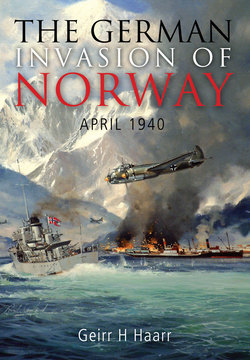Читать книгу The German Invasion of Norway - Geirr H. Haarr - Страница 9
ОглавлениеTHIS BOOK DOCUMENTS THE German invasion of Norway in April 1940 (Operation Weserübung), focusing on the events at sea.1 The objective is to give a balanced and factual account; readable but without compromising the demand for research and accurate detail.
As far as possible, the narrative has been based on primary sources. There is still an overwhelming amount of detail and anybody having information that would lead to modifications or improvements are more than welcome to contact me. The research material has come in many languages: Norwegian, German, English, Swedish, Danish and French. All translations into English are my own responsibility and where necessary I have striven to maintain the significance of what was said or written rather than create a word-by-word translation.
The military impact of Operation Weserübung has largely been overshadowed by the events on the Western Front and the fall of France, but there is no doubt that the invasion of Norway and the subsequent campaign had a significant influence on WWII in Europe. On paper, Germany had made a move of great strategic significance, breaking the British blockade of the North Sea and opening a potential to strike out towards the Atlantic. Lacking the resources to capitalise on the gains though, the conquest instead became a burden. The surface arm of the German Navy was small before the operation; afterwards it was crippled virtually beyond recovery. There were insufficient resources available to develop the full potential of the Norwegian bases and through the loss of many large surface ships the Kriegsmarine was, in reality, converted to a navy of small ships, incapable of even considering reaping any strategic gains from the venture. The Norwegian U-boat bases were of limited value compared to those on the French coast that became available very shortly after the Norwegian ones.
Nevertheless, Hitler and his senior staff were strengthened by Operation Weserübung and in spite of grave losses, the Führer consolidated his grip on the armed forces, paving the way for the campaigns in the West and in Russia.
The true strategic value of Norwegian territory appeared after the invasion of Russia in 1941, when northern Norway was used as a springboard for the polar front and the air and naval attacks on the supply route to Murmansk – neither of which were considered at all in 1940. Even after the attack on Russia it was difficult for the German Navy to find the resources to utilise the Norwegian ports and seaways to their full potential.
The loss of Norway and her territorial waters was in itself not catastrophic for the Allies but it took away an option to outflank Germany at the start of the campaign in France. Ironically, the most persuasive asset for either side prior to the events, the Swedish iron ore, was almost irrelevant afterwards. The supply to Germany continued virtually unaffected through the Baltic, and its strategic value diminished as the iron-ore mines in Lorraine were seized shortly after.
